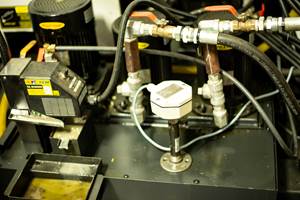Fixing Smelly Corroding Coolant Sumps Pays Off For Injection Mold Maker
As this company grew and the machine shop expanded, odor and corrosion started to gain the upper hand.
The coolant that for years had been used in the machine shop of Viking Tool & Engineering (Whitehall, Michigan) provided the parts quality needed. A little foul odor and corrosion of the sump tanks were par for the course.
The situation might not have changed if it weren’t for Viking’s success. As the company grew and the machine shop expanded, odor and corrosion started to gain the upper hand. Plant manager Rick Seaver wanted something done about it, noting that with “a couple of machines [it] was manageable, but at ten or 12, it was too much.”
Viking Tool designs and manufactures high-end injection molds used to fabricate all manner of plastic parts in the automotive, marine, toy, appliance and other industries. The molds are built to handle mass production of parts from a range of plastic and thermoplastic materials.
They are machined largely from a variety of stainless steels—P-20, H-13, S-7 and other tool steels—with some aluminum components. The finished products might range in weight from 200 pounds (enough to produce plastic parts measured in a few inches) to 35,000 pounds, all with discriminating surface specifications and parts thickness and other dimensional tolerances accurate to within a couple of thousandths of an inch.
In fabricating the molds, the contour work—the 3D machining—is performed on a series of shop-programmed CNCs using air-mist application of vegetable oil for cutting zone lubrication. But a coolant is most appropriate on the 2D machines that perform the “plate work”—drilling, tapping, milling and so forth.
Once the coolant sumps on the 2D machines started to go rancid, usually just 2 to 3 weeks after charging them, it never seemed possible to bring the fluid back to its original state. Deodorizing agents that made the shop smell like bubble gum softened the rank odor as the fluid systems were treated with biocides to stretch the viability of the coolant. Hockey puck-sized tablets of biocide were dissolved in the tanks as part of a treatment regimen aggressive enough to raise health concerns, but the effect was limited and not very durable.
The sumps would deteriorate quickly during periods of inactivity—inevitable downtime between setups caused by the way parts move through the shop—and when coolant may have been “capped off” by tramp oil for some time.
Aggressive corrosion could produce a leak in a tank within months of a repair, and machine operators needed constant vigilance in cleaning and protecting parts surfaces, especially the polished, contoured mold surfaces.
Tank corners and bottom sections were particularly troublesome; large sections of bottom plate—2 feet square or more—might be replaced with patches welded into place.
Viking Tool turned to Blaser Swisslube Inc. (Goshen, New York) for a solution. According to Blaser, the odor and corrosion Viking experienced were attributable to instabilities developing over time in the properties of the coolant formulation.
Viking chose a mineral-oil-based formulation for evaluation—Blasocut 4000. Given basic sump maintenance, the formulation is designed to tolerate bacterial concentrations as high as 10 million per cm3 and to maintain an ideal pH condition—a pH level of 8 to 9—over its range of recommended coolant concentrations.
For the purpose of evaluation, one of the worst afflicted machines was selected—a boring mill with a table large enough for a pick-up truck that was cleaned out every few weeks. Its coolant passage, measuring some 40 to 50 feet long, was difficult to clean and was suspected of contaminating fresh coolant charges.
The test results were good, and soon the coolant was introduced on all 2D machines. Now, 4 years later, Viking operates with the original coolant charge.
During this period, biocides have not been used to control bacterial growth. There has been no foul odor or signs of tank corrosion. The coolant has been found to protect machined surfaces, and skin disorders have cleared up (the coolant has a health rating of zero, considered benign in all regards).
Consumption is down. Previously, the replacements of coolant on all machine tools each month or two constituted the bulk of coolant concentrate usage—the fluid systems range in size from 40 to 150 gallons. Now, usage is limited to coolant make-up consumption, which each month ranges from 5 to 20 gallons per machine.
“The Blaser product is twice as expensive as the coolant we used before,” notes Mr. Seaver, “but the net effect of the changeover is that our coolant cost has been cut in half.”
Viking Tool has also found that when the coolant remains stable—retains all of its original properties—it performs better with the cutting tools. The tapping operations, which before required stopping the machine for manual application of a tapping compound, are faster with less breakage. Drilling operations with coolant-through-tools to make deep holes that used to be fed at 1.5 to 2 inches per minute are now fed at 3 to 7 inches per minute.
Shopwide, Mr. Seaver estimates that tool life has doubled, producing tangible improvements in uptime on the machine tools. “Changing individual tools does not take very long,” Mr. Seaver notes, “but it slows down the process. When an operator runs several machines, chances are that when he’s busy changing tools on one machine, there’s another sitting idle.”
Related Content
168 Manufacturing's Coolant System Automates Delivery
PMTS 2023: FullShop systems monitor and replenish all CNC machine sumps with optimized top-off ratios before the coolant runs low.
Read MoreManaging Coolant with Skimmers, Refractometers and More
Bacteria-infected coolant harms machines and sickens machinists. Coolant management technologies like skimmers and automated systems counter this tendency.
Read MoreSTLE To Host Metalworking Fluid Management Program
STLE’s program is a two-and-a-half-day education program offering a comprehensive overview of metalworking fluid management.
Read MoreHennig Inc. Acquires Industrial Coolant Systems
ICS develops and field tests high-pressure coolant systems, coolant filtration systems and other machine tool solutions.
Read MoreRead Next
3 Mistakes That Cause CNC Programs to Fail
Despite enhancements to manufacturing technology, there are still issues today that can cause programs to fail. These failures can cause lost time, scrapped parts, damaged machines and even injured operators.
Read MoreThe Cut Scene: The Finer Details of Large-Format Machining
Small details and features can have an outsized impact on large parts, such as Barbco’s collapsible utility drill head.
Read More













.png;maxWidth=300;quality=90)



.png;maxWidth=300;quality=90)







